Elecampane
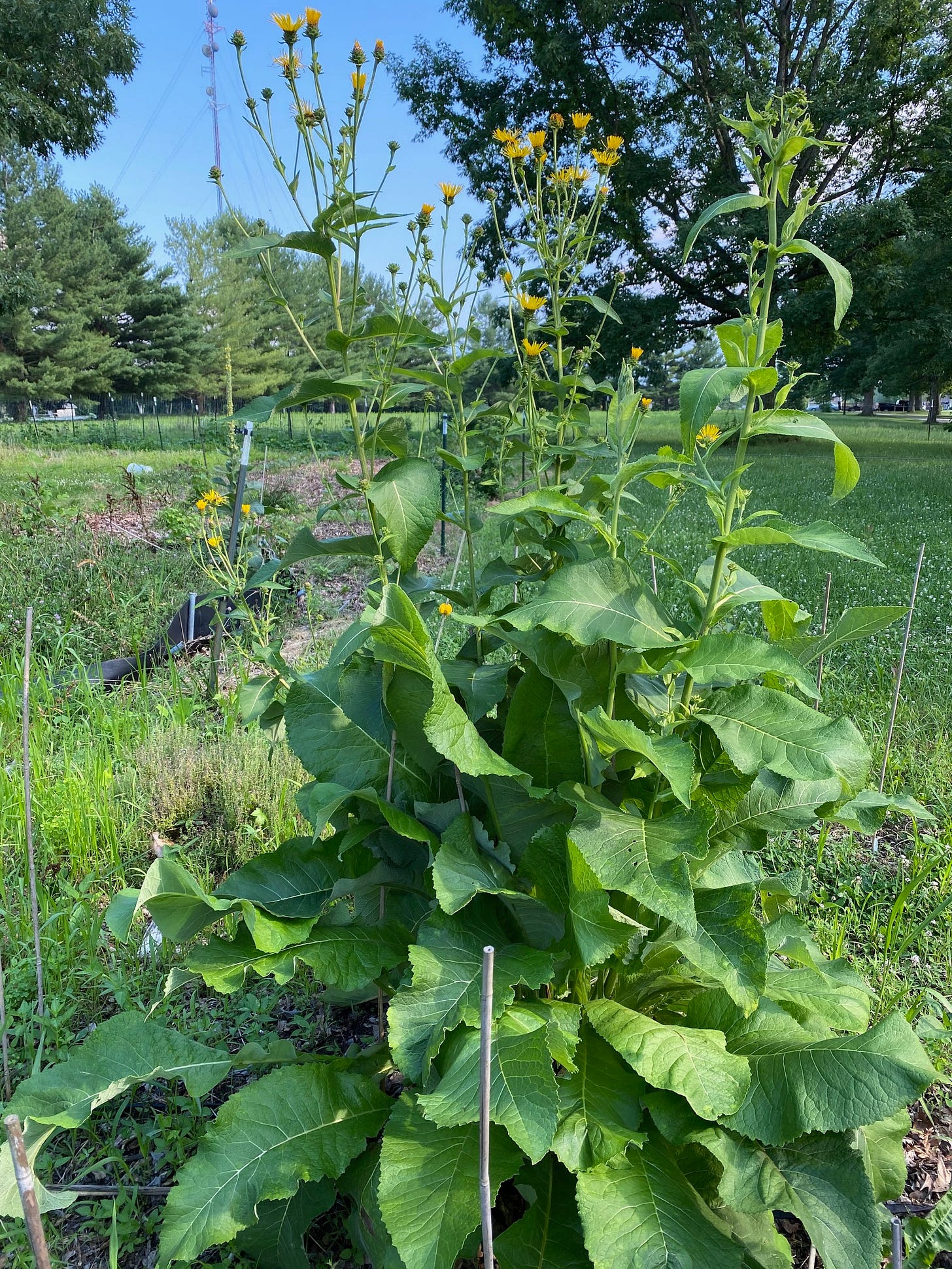
Despite its strong traditional postion in Western and Eastern herbalism for millenia, elecampane was relegated to the ash heap by the German Commission E. Possibly individual case reports of skin sensitization or allergic reactions to this plant (or to others within the genus contributed to this decision. The ESCOP monographs, WHO Selected Medicinal Herb monographs, the British Herbal Compendium, and the European Medicines Agency (EMA) Herbal Monographs followed suit by similarly excluding elecampane, cursing it to oblivion.
Meanwhile, elecampane has remained ever popular with the herbalists, having never lost its utility for addressing coughs, respiratory irritations, and innumerable other issues from the digestive tract to the brain. It remains resilient among the woo woo tribe of the plant loving community. Magical stories of elves, fairies and abductions abound. The woo power is so strong in this one, that no ash heap of medical science could bury it forever. The pervasive threat of antibiotic resistance has fueled renewed interest in the anti-bacterial and anti-fungal properties of the sesquiterpene lactones found in elecampane, so that it might one day be rehabilitated within the allopathic establishment.
It’s root digging time in many parts of the northern hemisphere, and a good time to ponder the utility of elecampane. Ours doesn’t look like its usual self due to the drought, but we have some identifiable first year plants. Normally we want wait for these roots til after the second or third year of growth.
It won’t help to see the sad plants that we sacrificed for some roots this year. They gave up their aerial parts over a month ago, but the roots are still bulky and usable. We washed scraped and sliced part of the roots very thinly, to soak in some honey. That’s the easy way to make them more palatable for those who don’t like their camphor and pinene straight. They can be eaten as lozenges, and the infused honey can be licked from the spoon or put into some tea.
Once you’ve handled the elliptical leaves of the elecampane, and appreciated the rough surface with the big midrib and netted veins, plus the fuzzy underside which sometimes rivals mullein, you’ll know these weeds anywhere. You’ll be able to distinguish them from the less hairy burdocks and smooth yellowdocks. Leaves often have wavy edges, which are irregularly serrated. The midrib accumulates a purply pigment which is most prominent in the leaf stems towards the base. Basal leaves can be a foot to three feet (0.3-0.9 meters) in length and up to a foot (0.3 meters) wide, with petioles up to a foot in length.
In later Spring one or hairy several flowering stems arise from the this perennial plant, which feature smaller sessile (clasping the stem) leaves. If you decide to adopt one of these plants, into your garden or landscape realize that it is one of the more enormous herbs which can take up a lot of real estate. It can grow up to 5 feet wide and over 6 feet in height when flowering. Plus, you’ll get plenty of free progeny, same as weedom :-D.
In the west, roots of elecampane are the big attraction, but Traditional Chinese Medicine makes use of the blooms too. As a member of family Asteraceae, elecampane puts out blooms in the form of large golden ‘daisies’ or ‘mini-sunflowers’. The blooms are about 3 inches (7.5 cm.) or so in diameter, with numerous hermaphroditic disk flowers and 20 to 100 thin ray flowers each with a few teeth at the outermost tip. The determinate type of flowering stem (cyme) on an older plant might produce 50-100 of these blooms, which give way to a fuzzy head of achene (single seeded) fruits, that spread somewhat like those of the dandelion.
Originally hailing from Eurasia, and used medicinally from Russia to the Middle East, elecampane migrated fairly recently to the U.S. likely by accident. It now occupies USDA zones 3 thru 8 preferring moist but well drained, partially shaded areas. The plant is naturalized in North America mainly from Nova Scotia to North Carolina in the east, and has spread west to Missouri. This plant has multitudinous common names. In English it’s called horse heal, velvet dock, elfwort, wild sunflower, or scabwort. In China, the root , (Tu Mu Xiang), the flower, (Xuan Fu Hua), and aerial parts, (Jun Fei Cao) are all used in medicine. Western cultures mainly have utilized the camphoraceous root, which contains up to 40% inulin, as food and medicine. Some foragers regard the bitter leaves as edible if cooked, but this seems not to be widespread. More frequently the roots are sliced and candied, or soaked in honey and used as an edible for cough. Historically the roots were used to flavor absinthe. Lately chefs have renewed interest in this root and are once more using it in confections and toppings. Furnace Creek Farm, located in Pennsylvania is making bank in NYC, selling candied elecampane to the public as well as online. Extracting spices, herbs and roots into honey to incorporate into foods and teas has become all the rage, even reaching our neck of the woods. The pungently aromatic root of elecampane, possesses oil glands which yield more than 4% essential oil containing mainly α-pinene, helenin (mix of alantolactone + isoalantolactone), camphor, α-terpenol, α-terpinene, limonene, linalool, and myrcene, igalan, alloalantolactone, dugesialactone and dozens of other minor constituents. Among other root constituents are predominantly inulin, and some saponins, sterols, resin, the tri-terpenoid friedelin, and a small amount of alkaloids. An array of mineral nutrients, including useful amounts of potassium, calcium, magnesium and a bit of iron are present.
It’s not just the inulin of elecampane which can address metabolic issues plaguing people in recent years. Compounds such as alantolactone and isoalantolactone appear to reduce the generation of fat cells, by regulating orphan nuclear receptor Nur77 and AMP-activated protein kinase α, which govern the early stages of adipogenesis. The fat reducing effects have been seen in mouse obesity models and the mechanism has been studied in vitro. Newer readers who want a quick look at how the plentiful inulin found in elecampane roots affects ghrelin, the hunger hormone, as well as glucagon-like peptides 1 and 2, to control appetite, and how it influences the flora and environment of the intestinal lumen and the gut associated lymphoid tissues, (GALT) head on over to the past article, Burdock 2 . It’s astonishing to find that compounds found in plants can be natural obesity fighters, and that we can mitigate this health issue by grazing weeds a little more, and eating less food that comes in boxes and plastic bags.
Numerous activities are attributed to the array of sesquiterpine lactones found in elecampane. Throughout the literature, cytotoxic activity and potential for tumor supression is attributed to them. Additionally they exhibit anti-inflammatory activity and considerable antimicrobial activity, which is supported by both long-standing traditional use and by in vitro experiments. Crude extracts of the root and guided extractions of the sesquiterpenoid compounds showed good activity against Staph aureus, inluding some resistant strains, Streptococcal species, Listeria monocytogenes, Escherichia coli and Mycobacterium tuberculosis. Antifungal activity has also been demonstrated against Candida albicans. This notable antimicrobial activity provides some backing for traditional uses of elecampane to address lung infection leading to pneumonia, or to tuberculosis, as well as the topical use of the herb for wounds, and conditions in which a scab does not form or the wound does not close and heal.
Elecampane has a place in the Russian herbal pharmacopoeia, notably for the treatment of lung inflammation and infection, as well as stomach ulcers. A standardized extract called Alanton has been on the market since 1979, shortly after a small clinical trial showed efficacy in the healing of ulcers and recovery from the symptoms. The recovery of gastric epithelium in all of the patients given this remedy was attributed to anti-inflammatory activity and stimulation of mucus production. Each Alanton tablet contains 100 mg of total sesquiterpene lactones, and the standard regimen for ulcer treatment is 3 tablets by mouth daily for 6-8 weeks. The elecampane treatment as an expectorant for upper respiratory tract infections is a decoction of 16 parts of the root to 200 parts water, dosed 100 ml. 2-3 times daily.
In western traditional western herbalism elecampane is regarded as an aromatic, warming herb that clears stagnant fluid. It has a diuretic action as well as expectorant action and activity as antispasmodic for smooth muscle. Traditionally it was applied for urinary stone and infections. Multiple mechanisms of anti-inflammatory action of this herb has been demonstrated in vitro. A syrup containing acacia honey, Inula helenium, Plantago major, Helichrysum stoechas and Malva sylvestris was found to be effective in alleviating cough in children via a randomized, double blind, placebo controlled trial. The tincture is described by David Hoffman as 1:5 ratio dried root in 40% ethanol with a dosage of 1-2 ml 3 times daily. Others suggest that the fresh root is preferred when available. As a medicinal, elecampane is more of an herb for treatment use, rather than as a preventative or tonic, so we don’t suggest continuous use. It’s also not recommended for pregnant or nursing moms.
Our roots, mentioned above, were allowed to partially dry for a couple days after we sliced them, and have been soaking in honey for a couple weeks. They taste pretty great already, and will be ready for the winter cold season. We’ll have more thoroughly dried roots for decoctions and tinctures.
Where We Dig
1. What Is Elecampane, the Powerful Root That Chefs Are Starting to Love? | Bon Appétit. Accessed November 6, 2024. https://www.bonappetit.com/story/what-is-elecampane
2. Wood M. The Earthwise Herbal - A Complete Guide to Old World Medicinal Plants. North Atlantic Books; 2008. https://openlibrary.org/books/OL12031143M/The_Earthwise_Herbal
3. Sustaining the Spirit : Elecampane Plant Profile. Worts + Cunning Apothecary | Intersectional Herbalism + Magickal Arts. Accessed October 29, 2024. http://www.wortsandcunning.com/blog/elecampane-plant-profile
4. Richard Whelan ~ Medical Herbalist ~ Elecampane. Accessed October 31, 2024. https://www.rjwhelan.co.nz/herbs%20A-Z/elecampane.html
5. Dudčenko LG, Kozʹjakov AS, Krivenko VV. Prjano-Aromatičeskie i Prjano-Vkusovye Rastenija: Spravočnik. Naukova dumka; 1989.
6. Stojanović-Radić Z, Comić L, Radulović N, Blagojevic PD, et al. (PDF) Antistaphylococcal activity of Inula helenium L. root essential oil: Eudesmane sesquiterpene lactones induce cell membrane damage. Eur J Clin Microbiol Infect Dis. 31(6):1015-1025.
7. Talebi M, Khoramjouy M, Feizi A, et al. Novel multi-target therapeutic potential of the genus Inula: Advances and opportunities for neuroprotection. Pharmacological Research - Modern Chinese Medicine. 2023;7:100263. doi:10.1016/j.prmcm.2023.100263
8. Shikov AN, Pozharitskaya ON, Makarov VG, Wagner H, Verpoorte R, Heinrich M. Medicinal Plants of the Russian Pharmacopoeia; their history and applications. Journal of Ethnopharmacology. 2014;154(3):481-536. doi:10.1016/j.jep.2014.04.007
9. Hoffmann D. Medical Herbalism: The Science and Practice of Herbal Medicine. Healing Arts Press; 2003.
10. O’Shea S, Lucey B, Cotter L. In vitro activity of Inula helenium against clinical Staphylococcus aureus strains including MRSA. British Journal of Biomedical Science. 2009;66(4):186-189. doi:10.1080/09674845.2009.11730271
11. Cech R. Growing Plant Medicine. Vol 2. Herbal Reeds, LLC; 2024.
12. Kenny CR, Stojakowska A, Furey A, Lucey B. From Monographs to Chromatograms: The Antimicrobial Potential of Inula helenium L. (Elecampane) Naturalised in Ireland. Molecules. 2022;27(4):1406. doi:10.3390/molecules27041406
13. Radi MH, El-Shiekh RA, El-Halawany AM, Abdel-Sattar E. Friedelin and 3β-Friedelinol: Pharmacological Activities. Rev Bras Farmacogn. 2023;33(5):886-900. doi:10.1007/s43450-023-00415-5
14. Elecampane with Henriette Kress. Accessed November 6, 2024. https://www.herbalremediesadvice.org/podcast67.html
15. Adamant A. Elecampane Tincture. Practical Self Reliance. December 16, 2023. Accessed October 29, 2024. https://practicalselfreliance.com/elecampane-tincture/
16. Elecampane Root Benefits: A Comprehensive Guide to Its Uses and Health Benefits | East West Herbal. March 22, 2023. Accessed October 29, 2024. https://eastwestherbal.com/elecampane-root-benefits-a-comprehensive-guide-to-its-uses-and-health-benefits/
17. Hayes R. Elecampane Monograph - Eclectic School of Herbal Medicine. July 3, 2017. Accessed October 29, 2024. https://eclecticschoolofherbalmedicine.com/elecampane-monograph/
18. Jung YS, Jeong YJ, Kim JH, Jeon CH, Lee SO. Elecampane (Inula helenium) Root Extract and Its Major Sesquiterpene Lactone, Alantolactone, Inhibit Adipogenesis of 3T3-L1 Preadipocytes. Molecules. 2022;27(15):4765. doi:10.3390/molecules27154765
19. Elecampane. White Rabbit Institute of Healing. Accessed October 29, 2024. https://www.whiterabbitinstituteofhealing.com/herbs/elecampane/
20. Carnevali I, Paglia RL, Pauletto L, et al. Efficacy and safety of the syrup “KalobaTUSS®” as a treatment for cough in children: a randomized, double blind, placebo-controlled clinical trial. BMC Pediatrics. 2021;21:29. doi:10.1186/s12887-020-02490-2
21. Stojanović-Radić Z, Dimitrijević M, Genčić M, Pejčić M, Radulović N. Anticandidal activity of Inula helenium root essential oil: Synergistic potential, anti-virulence efficacy and mechanism of action. Industrial Crops and Products. 2020;149:112373. doi:10.1016/j.indcrop.2020.112373




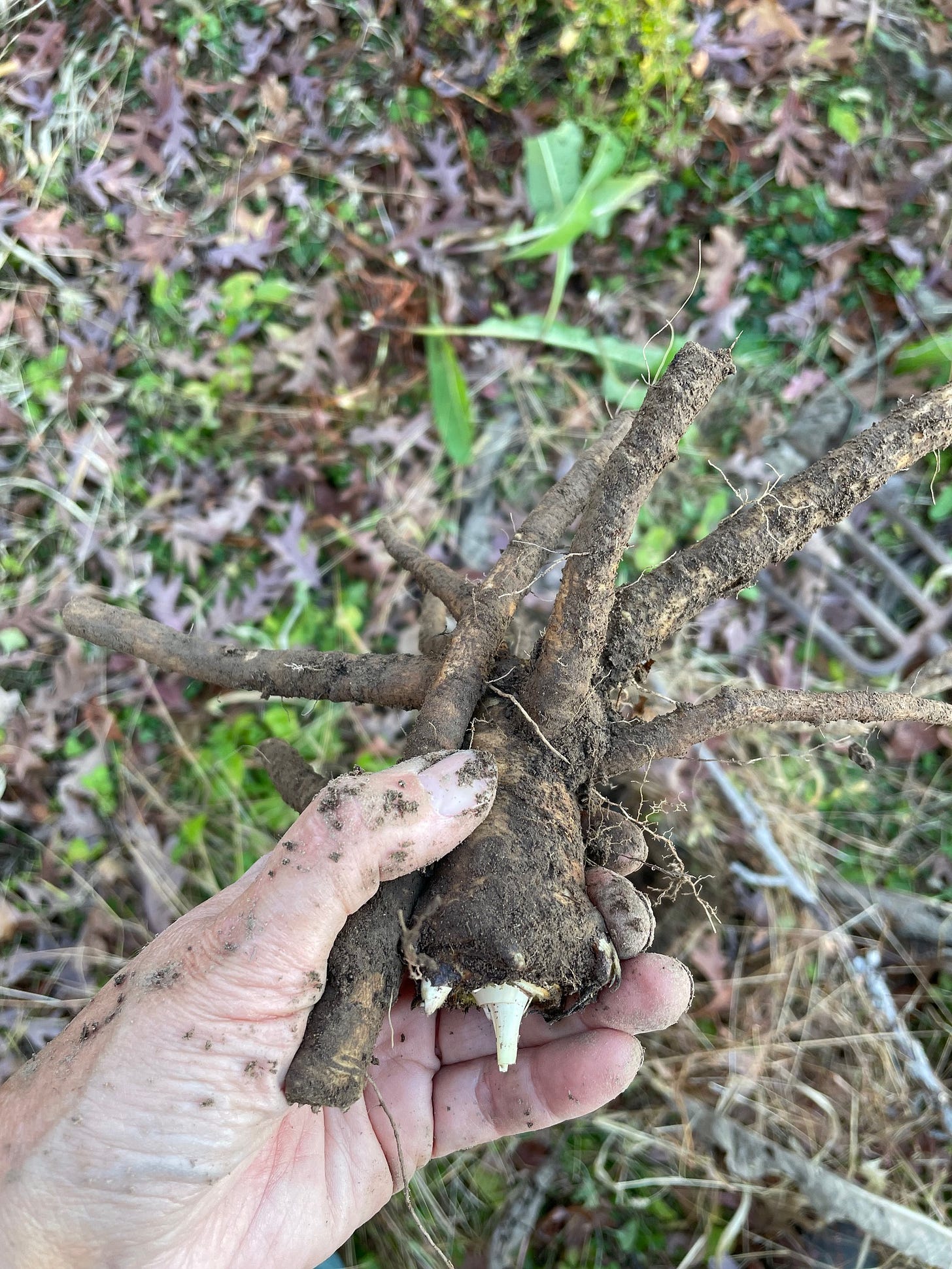
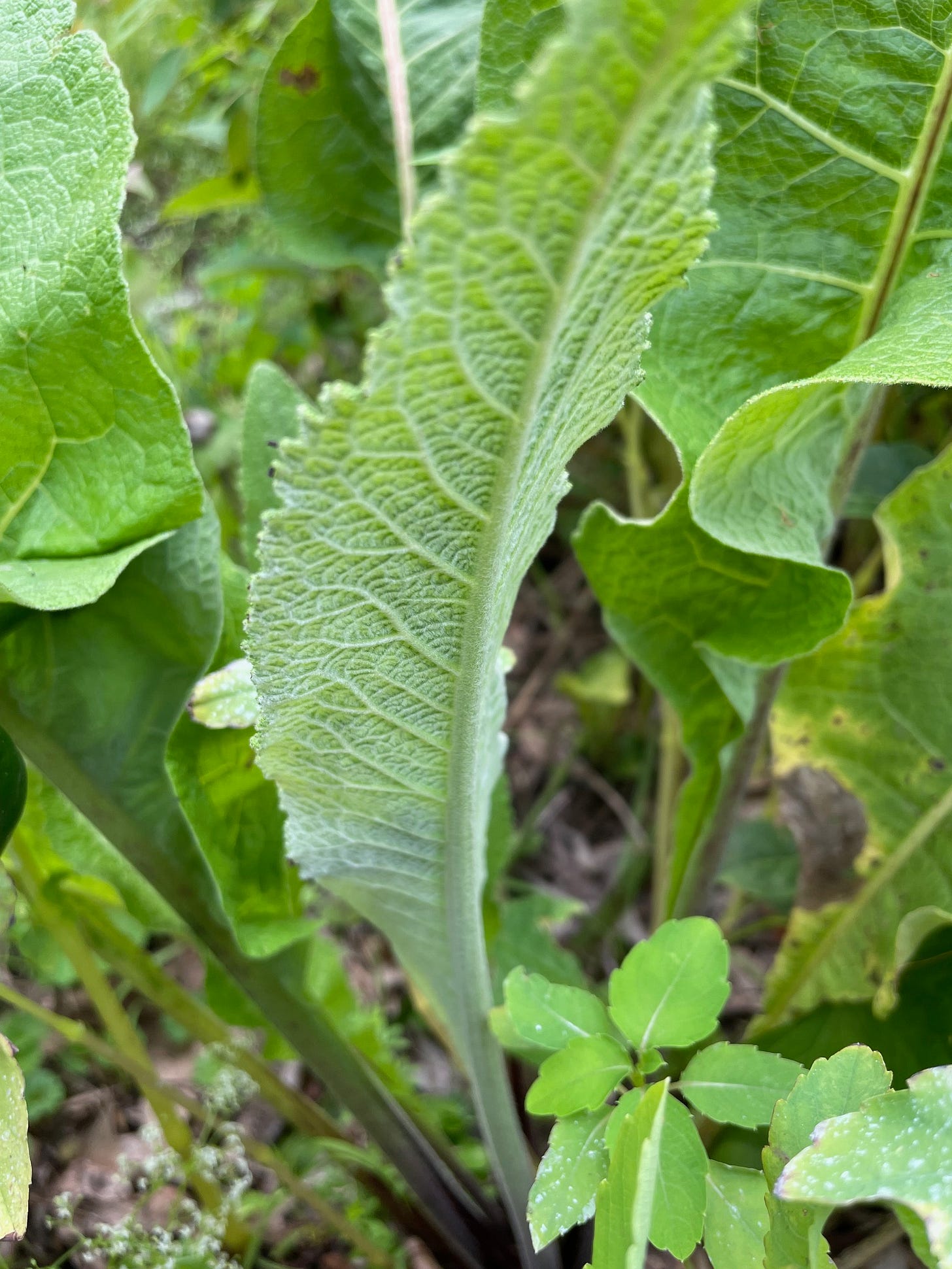
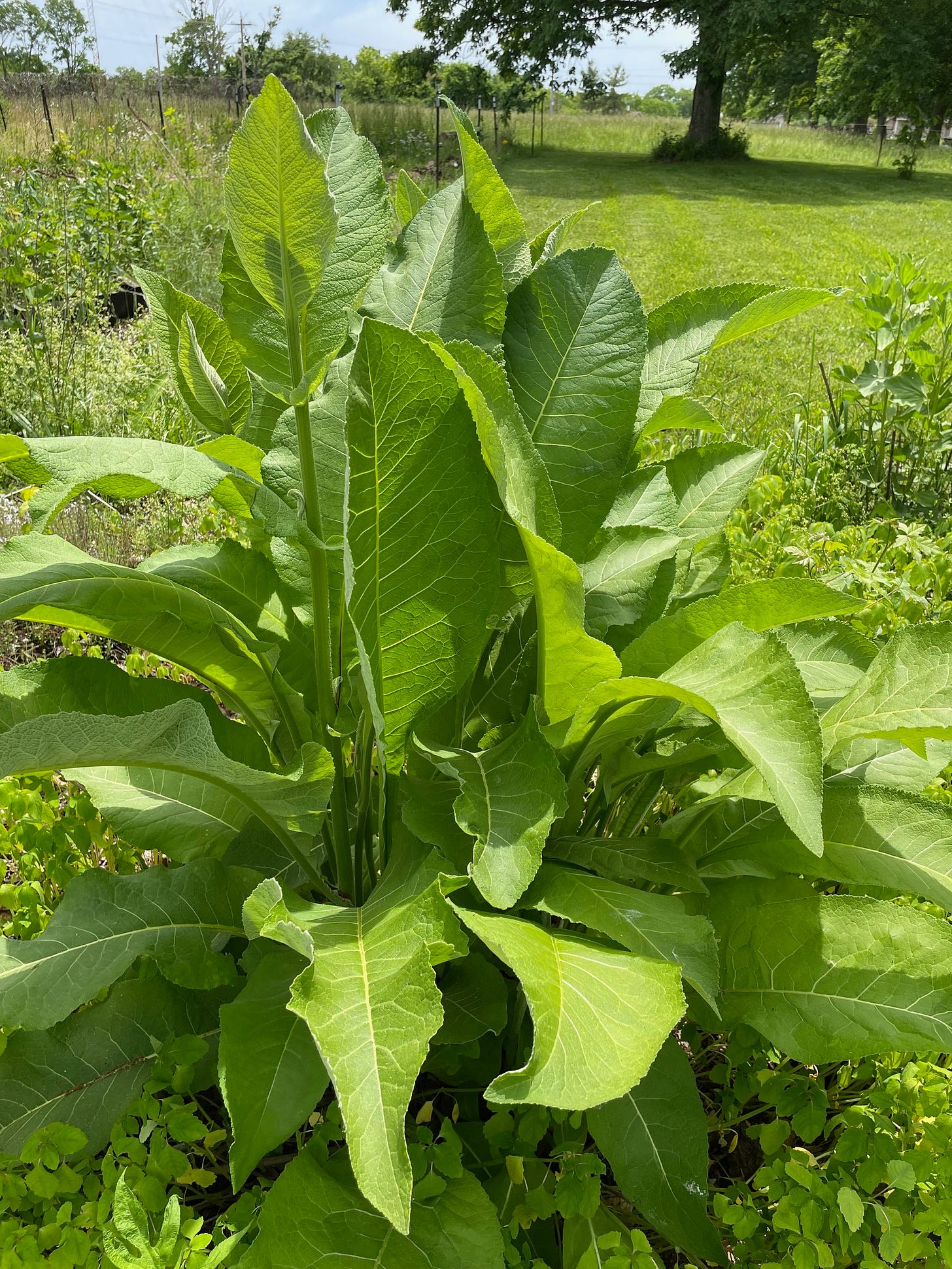
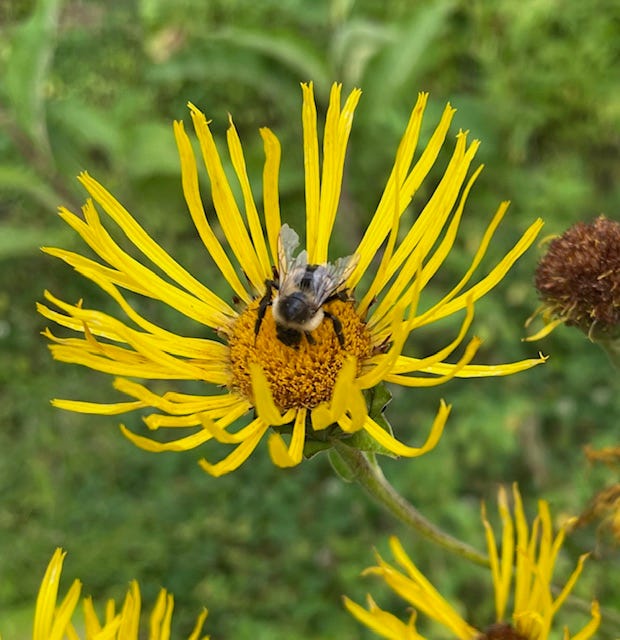

How old would you say that first picture/plant is? Huge & sooooo pretty. I would love to plant them.
That was probably in its 4th year when the pic was taken. And 2 or 3 year plants are enough to give you big roots. Plus you can steal some roots or rhizomes from a big plant and it’ll survive. It can by the rhizomes and also by seed.